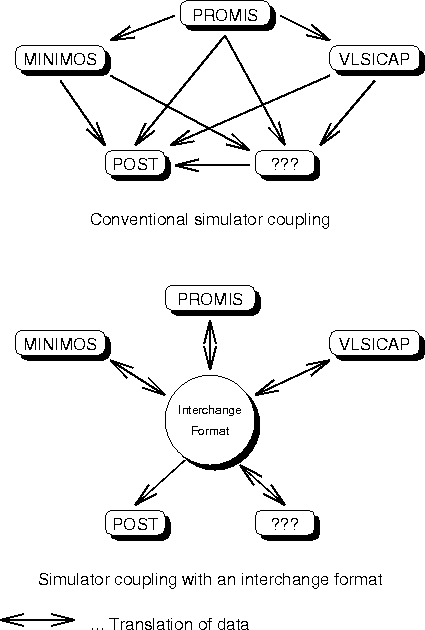3.1 Interchange Formats




Next: 3.1.1 Textual Representation
Up: 3 Concepts of Data
Previous: 3 Concepts of Data
The data level concept of an interchange format is - at one hand - targeted
at avoiding file-format conversions between tool invocation inside a TCAD
framework. Consider the two cases of simulator coupling depicted in
Fig. 3.2. The upper figure shows conventional simulator coupling
through converters between several incompatible and disjunct simulator input
and output data formats. As can easily be seen, the number of converters
necessary in such a ``framework'' rises with  , where
, where  is
the number of simulators. With each new simulator which has to be integrated,
is
the number of simulators. With each new simulator which has to be integrated,
 converters would have to be written for both input and output data
formats. Besides from the fact that this large number of converters (or
wrappers) will be virtually unmanageable, it is inefficient and tedious to
integrate a TCAD tool this way. The obvious solution to this problem is to
force a TCAD tool to understand and write a common framework format used by
all tools - the interchange format.
converters would have to be written for both input and output data
formats. Besides from the fact that this large number of converters (or
wrappers) will be virtually unmanageable, it is inefficient and tedious to
integrate a TCAD tool this way. The obvious solution to this problem is to
force a TCAD tool to understand and write a common framework format used by
all tools - the interchange format.
The second case in Fig. 3.2 shows this situation: Each integrated
tool reads and writes the interchange format either directly or via a
wrapper. Integrating a new tool is only a matter of creating just one new
wrapper which converts the tool's individual data formats to the interchange
format and vice versa. The number of converters just rises by the number
of integrated simulators  .
.
But it is not only this fact that makes the interchange format approach an
intriguing data level concept:
- The interchange format can be extended to also keep any relevant
framework data, not only data which is needed by the individual tools. Of
course this can be only done if the wrappers or tools ignore this additional
information, but then a single format would suffice to describe all
kinds of different data occurring inside a TCAD framework.
- The interchange format could be adopted as a standard file format used
among TCAD tool developers and vendors. The user has the advantage that any
tool he uses will fit ad hoc into his framework, no matter where he got
this tool from.
- The interchange format can serve not only as an intertool data
format used between tools, but also as an intersite exchange format,
when TCAD data needs to be communicated and transmitted between different
sites.
These issues are the reason why the vast majority of existing data level
implementations uses the interchange file approach. However, there exist a
number of TCAD frameworks which do not provide a central interchange
format. As becomes obvious from above, this is only a viable solution if the
number of simulators and hence the number of converters can be kept small.
Virtually all of those systems at least use a central data management tool
which is responsible for the appropriate data conversions.

Figure: Tool coupling without and with usage of an
interchange format. Data paths between the process simulator
PROMIS [Pich85], the device simulator MINIMOS [Thur90][Kosi94], the
capacitance simulator VLSICAP [Stra86], and the graphical
postprocessor POST (internal tool) are shown.
The MECCA system of AT& [Lloy93][Lloy90] uses UNIX system
tools like awk and sed to perform the necessary conversions and
prepare data files prior to tool invocation. The IBM TCAD system
[Knep93] provides a database manager called VATS/DB which is
responsible for simulation data preparation. Both systems provide a task level
using the popular TCL extension language [Oust90], and a user
interface based on the TCL/TK X11 toolkit [Sche88][O'Re90][Oust91].
The SIEMENS SATURN framework [Jaco90][Jaco93] is based on the
UNIX shell environment and its commands, but already provides a simple
interchange format mainly used for visualization purposes. Through the MEDLEY data controller the P& WORKBENCH [Tana93] of NEC prepares simulator input and processes output data. The UNISAS
[Nish93] system of OKI exhibits at least a common graphics file
format called VSRF.




Next: 3.1.1 Textual Representation
Up: 3 Concepts of Data
Previous: 3 Concepts of Data
Martin Stiftinger
Tue Nov 29 19:41:50 MET 1994
 , where
, where  is
the number of simulators. With each new simulator which has to be integrated,
is
the number of simulators. With each new simulator which has to be integrated,
 converters would have to be written for both input and output data
formats. Besides from the fact that this large number of converters (or
wrappers) will be virtually unmanageable, it is inefficient and tedious to
integrate a TCAD tool this way. The obvious solution to this problem is to
force a TCAD tool to understand and write a common framework format used by
all tools - the interchange format.
converters would have to be written for both input and output data
formats. Besides from the fact that this large number of converters (or
wrappers) will be virtually unmanageable, it is inefficient and tedious to
integrate a TCAD tool this way. The obvious solution to this problem is to
force a TCAD tool to understand and write a common framework format used by
all tools - the interchange format.




